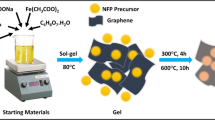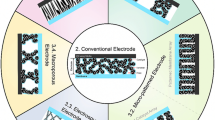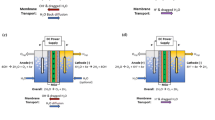Abstract
A novel phosphorylated graphene oxide (PGO)-reinforced polybenzimidazole (PBI) composite membrane was prepared for high-temperature proton exchange membrane fuel cell (HT-PEMFC). PGO was prepared by phosphorylation of graphene oxide (GO) with phosphoric acid (PA), and its structure was characterized by Fourier transform infrared spectroscopy (FTIR), X-ray diffraction (XRD), Raman spectroscopy, X-ray photoelectron spectroscopy (XPS), energy dispersive spectrometry (EDS), and ion exchange capacity (IEC) measurement. Then, PGO was added into PBI to prepare composite membranes, with excellent oxidation and thermal stability, outstanding mechanical properties, strong PA uptake and high proton conductivity. The PBI composite membrane with 1.5 wt.% of PGO exhibits the highest tensile strength (38.4 MPa) and excellent proton conductivity (17.6 mS·cm−1 at 180 ℃ without moisture) after immersion in PA aqueous solution, which is 1.31 and 1.15 times higher than that of pure PBI and PBI/GO composite membranes, respectively. Thus, PGO-reinforced PBI composite membranes have promising applications in HT-PEMFC.



















Similar content being viewed by others
References
Jiang ZQ, Jiang ZJ (2014) Plasma techniques for the fabrication of polymer electrolyte membranes for fuel cells. J Membrane Sci 456:85–106. https://doi.org/10.1016/j.memsci.2014.01.004
Hasani-Sadrabadi MM, Dashtimoghadam E, Mokarram N, Majedi FS, Jacob KI (2012) Triple-layer proton exchange membranes based on chitosan biopolymer with reduced methanol crossover for high-performance direct methanol fuel cells application. Polymer 53(13):2643–2651. https://doi.org/10.1016/j.polymer.2012.03.052
Vinayan BP, Nagar R, Rajalakshmi N, Ramaprabhu S (2012) Adv Funct Mater 22(16):3519–3526. https://doi.org/10.1002/adfm.201102544
Li Q, Jensen JO, Savinell RF, Bjerrum NJ (2009) Prog Polym Sci 34(5):449–477. https://doi.org/10.1016/j.progpolymsci.2008.12.003
Neburchilov V, Martin J, Wang H, Zhang J (2007) J Power Sources 169(2):221–238. https://doi.org/10.1016/j.jpowsour.2007.03.044
Qiu X, Dong T, Ueda M, Zhang X, Wang L (2017) J Membrane Sci 524:663–672. https://doi.org/10.1016/j.memsci.2016.11.064
Rozière J, Jones DJ (2003) Annu Rev Mater Res 33(1):503–555. https://doi.org/10.1146/annurev.matsci.33.022702.154657
Alberti G, Narducci R, Sganappa M (2008) J Power Sources 178(2):575–583. https://doi.org/10.1016/j.jpowsour.2007.09.034
Li J, Li X, Yu S, Hao J, Lu W, Shao Z, Yi B (2014) Energ Convers Manage 85:323–327. https://doi.org/10.1016/j.enconman.2014.05.052
Hickner MA, Ghassemi H, Kim YS, Einsla BR, McGrath JE (2004) Chem Rev 104(10):4587–4612. https://doi.org/10.1021/cr020711a
Kreuer KD, Rabenau A, Weppner W (1982) Angew Chem 94(3):224–225. https://doi.org/10.1002/ange.19820940335
Agmon N (1995) Chem Phys Lett 244(5):456–462. https://doi.org/10.1016/0009-2614(95)00905-J
Wang S, Zhao C, Ma W, Zhang G, Liu Z, Ni J, Li M, Zhang N, Na H (2012) J Membrane Sci 411–412:54–63. https://doi.org/10.1016/j.memsci.2012.04.011
Chuang S-W, Hsu SL-C, Liu Y-H (2007) Synthesis and properties of fluorine-containing polybenzimidazole/silica nanocomposite membranes for proton exchange membrane fuel cells. J Membrane Sci 305(1): 353–363. https://doi.org/10.1016/j.memsci.2007.08.033
Joseph D, Krishnan NN, Henkensmeier D, Jang JH, Choi SH, Kim H-J, Han J, Nam SW (2017) Thermal crosslinking of PBI/sulfonated polysulfone based blend membranes. J Mater Chem A 5(1):409–417. https://doi.org/10.1039/C6TA07653J
Cai Y, Zhouying Y, Xin T, Shiai X (2018) Phosphoric acid doped crosslinked polybenzimidazole/modified graphene oxide composite membranes for high temperature proton exchange membrane applications. J Electrochem Soc 165(11):914–920. https://doi.org/10.1149/2.0051811jes
Tao P, Dai Y, Chen S, Wang J, He R (2020) Hyperbranched polyamidoamine modified high temperature proton exchange membranes based on PTFE reinforced blended polymers. J Membrane Sci 604:118004. https://doi.org/10.1016/j.memsci.2020.118004
Wang P, Liu Z, Li X, Peng J, Hu W, Liu B (2019) Toward enhanced conductivity of high-temperature proton exchange membranes: development of novel PIM-1 reinforced PBI alloy membranes. Chem Commun 55(46):6491–6494. https://doi.org/10.1039/C9CC02102G
He Y, Tong C, Geng L, Liu L, Lü C (2014) Enhanced performance of the sulfonated polyimide proton exchange membranes by graphene oxide: Size effect of graphene oxide. J Membrane Sci 458:36–46. https://doi.org/10.1016/j.memsci.2014.01.017
Cele N, Ray SS (2009) Recent progress on Nafion-based nanocomposite membranes for fuel cell applications. Macromol Mater Eng 294(11):719–738. https://doi.org/10.1002/mame.200900143
Jiang Z, Zhao X, Fu Y, Manthiram A (2012) Composite membranes based on sulfonated poly(ether ether ketone) and SDBS-adsorbed graphene oxide for direct methanol fuel cells. J Mater Chem 22(47):24862–24869. https://doi.org/10.1039/C2JM35571J
Lee DC, Yang HN, Park SH, Kim WJ (2014) Nafion/graphene oxide composite membranes for low humidifying polymer electrolyte membrane fuel cell. J Membrane Sci 452:20–28. https://doi.org/10.1016/j.memsci.2013.10.018
Ye Y-S, Cheng M-Y, Xie X-L, Rick J, Huang Y-J, Chang F-C, Hwang B-J (2013) Alkali doped polyvinyl alcohol/graphene electrolyte for direct methanol alkaline fuel cells. J Power Sources 239:424–432. https://doi.org/10.1016/j.jpowsour.2013.03.021
Ibrahim A, Hossain O, Chaggar J, Steinberger-Wilckens R, El-Kharouf A (2020) GO-nafion composite membrane development for enabling intermediate temperature operation of polymer electrolyte fuel cell. Int J Hydrogen Energ 45(8):5526–5534. https://doi.org/10.1016/j.ijhydene.2019.05.210
Cai Y, Yue Z, Xu S (2017) A novel polybenzimidazole composite modified by sulfonated graphene oxide for high temperature proton exchange membrane fuel cells in anhydrous atmosphere. J Appl Polym Sci 134(25):44986. https://doi.org/10.1002/app.44986
Ahmed S, Cai Y, Ali M, Khannal S, Ahmad Z, Lu Y, Wang S, Xu S (2019) One-step phosphorylation of graphene oxide for the fabrication of nanocomposite membranes with enhanced proton conductivity for fuel cell applications. J Mater Sci-Mater El 30(14):13056–13066. https://doi.org/10.1007/s10854-019-01667-5
Wu H, Shi H, Wang Y, Jia X, Tang C, Zhang J, Yang S (2014) Hyaluronic acid conjugated graphene oxide for targeted drug delivery. Carbon 69:379–389. https://doi.org/10.1016/j.carbon.2013.12.039
Liu T, Su H, Qu X, Ju P, Cui L, Ai S (2011) Acetylcholinesterase biosensor based on 3-carboxyphenylboronic acid/reduced graphene oxide–gold nanocomposites modified electrode for amperometric detection of organophosphorus and carbamate pesticides. Sensor Actuat B-Chem 160(1):1255–1261. https://doi.org/10.1016/j.snb.2011.09.059
Xu C, Liu X, Cheng J, Scott K (2015) A polybenzimidazole/ionic-liquid-graphite-oxide composite membrane for high temperature polymer electrolyte membrane fuel cells. J Power Sources 274:922–927. https://doi.org/10.1016/j.jpowsour.2014.10.134
Smitha B, Sridhar S, Khan AA (2004) Polyelectrolyte complexes of chitosan and poly(acrylic acid) as proton exchange membranes for fuel cells. Macromolecules 37(6):2233–2239. https://doi.org/10.1021/ma0355913
Mack F, Aniol K, Ellwein C, Kerres J, Zeis R (2015) Novel phosphoric acid-doped PBI-blends as membranes for high-temperature PEM fuel cells. J Mater Chem A 3(20):10864–10874. https://doi.org/10.1039/C5TA01337B
Marcano DC, Kosynkin DV, Berlin JM, Sinitskii A, Sun Z, Slesarev A, Alemany LB, Lu W, Tour JM (2010) Improved synthesis of graphene oxide. ACS Nano 4(8):4806–4814. https://doi.org/10.1021/nn1006368
Achary LSK, Kumar A, Rout L, Kunapuli SVS, Dhaka RS, Dash P (2018) Phosphate functionalized graphene oxide with enhanced catalytic activity for Biginelli type reaction under microwave condition. Chem Eng J 331:300–310. https://doi.org/10.1016/j.cej.2017.08.109
Xu C, Wu X, Zhu J, Wang X (2008) Synthesis of amphiphilic graphite oxide. Carbon 46(2):386–389. https://doi.org/10.1016/j.carbon.2007.11.045
Venkatasubramanian N, Dean DR, Dang TD, Price GE, Arnold FE (2000) Solvent cast thermoplastic and thermoset rigid-rod molecular composites. Polymer 41(9):3213–3226. https://doi.org/10.1016/S0032-3861(99)00510-8
Chien H-C, Tsai L-D, Huang C-P, Kang C-y, Lin J-N, Chang F-C (2013) Sulfonated graphene oxide/Nafion composite membranes for high-performance direct methanol fuel cells. International Journal of Hydrogen Energy 38(31):13792–13801. https://doi.org/10.1016/j.ijhydene.2013.08.036
Xue C, Zou J, Sun Z, Wang F, Han K, Zhu H (2014) Graphite oxide/functionalized graphene oxide and polybenzimidazole composite membranes for high temperature proton exchange membrane fuel cells. Int J Hydrogen Energ 39(15):7931–7939. https://doi.org/10.1016/j.ijhydene.2014.03.061
Rafiee MA, Rafiee J, Wang Z, Song H, Yu Z-Z, Koratkar N (2009) Enhanced mechanical properties of nanocomposites at low graphene content. ACS Nano 3(12):3884–3890. https://doi.org/10.1021/nn9010472
Geng L, He Y, Liu D, Dai X, Lü C (2012) Facile in situ template synthesis of sulfonated polyimide/mesoporous silica hybrid proton exchange membrane for direct methanol fuel cells. Micropor Mesopor Mat 148(1):8–14. https://doi.org/10.1016/j.micromeso.2011.07.010
Kowsari E, Zare A, Ansari V (2015) Phosphoric acid-doped ionic liquid-functionalized graphene oxide/sulfonated polyimide composites as proton exchange membrane. Int J Hydrogen Energ 40(40):13964–13978. https://doi.org/10.1016/j.ijhydene.2015.08.064
Sun P, Wang Y, Li Z, Wang C, Pei H, Yin X (2020) Organic-inorganic backbone with high contents of proton conducting groups: A newly designed high performance proton conductor. Int J Hydrogen Energ 45(28):14407–14412. https://doi.org/10.1016/j.ijhydene.2020.03.148
Zhou Y, Yang J, Su H, Zeng J, Jiang SP, Goddard WA (2014) Insight into proton transfer in phosphotungstic acid functionalized mesoporous silica-based proton exchange membrane fuel cells. J Am Chem Soc 136(13):4954–4964. https://doi.org/10.1021/ja411268q
Iizuka Y, Tanaka M, Kawakami H (2013) Preparation and proton conductivity of phosphoric acid-doped blend membranes composed of sulfonated block copolyimides and polybenzimidazole. Polym Int 62(5):703–708. https://doi.org/10.1002/pi.4486
Suzuki K, Iizuka Y, Tanaka M, Kawakami H (2012) Phosphoric acid-doped sulfonated polyimide and polybenzimidazole blend membranes: high proton transport at wide temperatures under low humidity conditions due to new proton transport pathways. J Mater Chem 22(45):23767–23772. https://doi.org/10.1039/C2JM34529C
Lechner RE (1995) Neutron investigations of superprotonic conductors. Ferroelectrics 167(1):83–98. https://doi.org/10.1080/00150199508007723
Xiao L, Zhang H, Jana T, Scanlon E, Chen R, Choe EW, Ramanathan LS, Yu S, Benicewicz BC (2005) Synthesis and characterization of pyridine-based polybenzimidazoles for high temperature polymer electrolyte membrane fuel cell applications. Fuel Cells 5(2):287–295. https://doi.org/10.1002/fuce.200400067
Plackett D, Siu A, Li Q, Pan C, Jensen JO, Nielsen SF, Permyakova AA, Bjerrum NJ (2011) High-temperature proton exchange membranes based on polybenzimidazole and clay composites for fuel cells. J Membrane Sci 383(1):78–87. https://doi.org/10.1016/j.memsci.2011.08.038
Yang J, Xu Y, Liu P, Gao L, Che Q, He R (2015) Epoxides cross-linked hexafluoropropylidene polybenzimidazole membranes for application as high temperature proton exchange membranes. Electrochim Acta 160:281–287. https://doi.org/10.1016/j.electacta.2015.01.094
Wang S, Zhang G, Han M, Li H, Zhang Y, Ni J, Ma W, Li M, Wang J, Liu Z, Zhang L, Na H (2011) Novel epoxy-based cross-linked polybenzimidazole for high temperature proton exchange membrane fuel cells. Int J Hydrogen Energ 36(14):8412–8421. https://doi.org/10.1016/j.ijhydene.2011.03.147
Yang J, Li Q, Cleemann LN, Xu C, Jensen JO, Pan C, Bjerrum NJ, He R (2012) Synthesis and properties of poly(aryl sulfone benzimidazole) and its copolymers for high temperature membrane electrolytes for fuel cells. J Mater Chem 22(22):11185–11195. https://doi.org/10.1039/C2JM30217A
Acknowledgements
This research is financially supported by the National Natural Science Foundation of China (21764011), the Foundation from Qinghai Science and Technology Department (2020-HZ-808), Thousand Talents Program of Qinghai Province and Shanghai Aerospace Science and Technology Innovation Foundation.
Author information
Authors and Affiliations
Corresponding author
Ethics declarations
Conflict of interest
There are no conflicts of interests.
Additional information
Publisher's Note
Springer Nature remains neutral with regard to jurisdictional claims in published maps and institutional affiliations.
Highlights
• PGO was synthesized by a facile one-step approach.
• PGO leads to formation of new proton channels and improvement of proton conductivity.
• PBI/PGO-1.5%-PA composite exhibits the highest tensile strength (38.4 MPa) and excellent proton conductivity (17.6 mS·cm−1) at 180 ℃ without moisture.
Supplementary Information
Below is the link to the electronic supplementary material.
Rights and permissions
About this article
Cite this article
Zhao, X., Nan, B., Lu, Y. et al. Phosphorylated graphene oxide-reinforced polybenzimidazole composite membrane for high-temperature proton exchange membrane fuel cell. J Polym Res 28, 480 (2021). https://doi.org/10.1007/s10965-021-02846-x
Received:
Accepted:
Published:
DOI: https://doi.org/10.1007/s10965-021-02846-x




